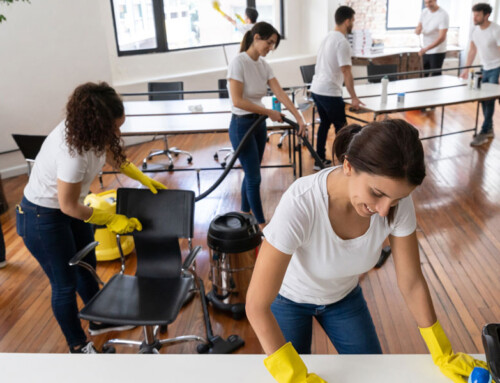The Importance of Cleaning and Hygiene on Indoor Air Quality

I recently was asked how cleaning affects indoor air quality (IAQ). My initial response was one of surprise. Of course! Isn’t it obvious? It might not be for everyone.
As we see new guidelines coming from organizations such as the American Society of Heating, Refrigerating and Air-Conditioning Engineers (ASHRAE) and government agencies such as Centers for Disease Control and Prevention (CDC), the National Institute for Occupational Safety and Health (NIOSH), the U.S. Environmental Protection Agency (EPA), and the World Health Organization (WHO), regarding ventilation for healthy buildings promoting health and wellness worldwide, we are starting to recognize that we are at the forefront of an IAQ revolution, one that is long overdue.
What is the importance of cleaning and hygiene in IAQ? I asked individuals such as air quality experts, cleaning industry professionals, and industrial hygienists. In general, whatever we do is directly related to removing potential IAQ issues and/or preventing them firsthand.
Cleaning, hygiene, and IAQ
Here are 10 reasons why cleaning and hygiene for health are essential to IAQ and wellness:
- Removal of allergens: Regular cleaning helps to remove allergens such as dust, pollen, and pet dander, which can trigger allergies, asthma, and other respiratory issues. By reducing exposure to these allergens, cleaning supports respiratory health and overall well-being.
- Reduction of dust mites: Dust mites are microscopic pests that can trigger allergies and asthma. Regular cleanings, such as vacuuming and dusting, helps reduce the population of dust mites, improving respiratory health and overall comfort.
- Prevention of mold growth: Moisture and dampness can lead to mold growth, affecting IAQ and posing health risks. Mold spores can cause allergic reactions, respiratory problems, and even infections. Regular cleaning, humidity control, and maintenance help prevent mold growth, ensuring a healthier indoor environment.
- Reduction of indoor air pollutants and chemical exposure: “Cleaning the air” with air cleaners and proper ventilation removes indoor pollutants, including volatile organic compounds (VOCs) released by household products, paints, and cleaning agents. Minimizing VOC exposure through acceptable cleaning practices improves IAQ and reduces the risk of associated health issues.
- Cleaning products often contain chemicals that IAQ and human health. Using environmentally friendly and low-toxicity cleaning agents and ensuring proper ventilation during cleaning activities can minimize exposure to harmful chemicals, promoting a healthier indoor environment.
- Control of indoor odors: Cleaning practices help eliminate unpleasant odors caused by various sources, including stagnant air and bacterial growth. Fresh and clean indoor environments promote a sense of well-being and contribute to a healthier living or working space.
- Maintenance of HVAC systems: Proper cleaning and maintenance are crucial for IAQ and overall health. Regularly cleaning filters, ducts, and vents prevents the accumulation of dust, allergens, and pathogens, ensuring clean and healthy air circulation. It also helps with energy conservation. Systems that are maintained run more efficiently.
- Maintenance of clean and healthy surfaces: Regular cleaning improves air quality and helps maintain clean and healthy surfaces. While many question how the cleaning of surfaces impacts IAQ, an easy example is that when we remove dirt, dust, molds, bacteria, and viruses from surfaces, we reduce what has the potential to become airborne.
- Monitoring plays a critical role in healthy IAQ. “What is measured gets managed.” It makes all the difference in identifying problems or showing that the facility maintains healthy IAQ. It can assist in identifying areas for improvement, supporting sustainability efforts and cost savings when we look at energy consumption, and promoting sustainable and environmentally safe chemistries and cleaning techniques.
- A critical point to stress is the resilience to future outbreaks and pandemics. We must maintain sight of this after our experiences over the last three years. Prioritizing hygiene and cleaning practices is crucial for building resilience to future infectious disease outbreaks and pandemics. By maintaining clean and healthy indoor environments, we create a strong line of defense against pathogens, reducing the risk of transmission and ensuring the well-being of individuals and communities.
In conclusion
Hygiene, cleaning, and monitoring are integral to achieving and maintaining healthy IAQ. We create clean, comfortable indoor environments that support well-being by emphasizing proper hygiene and regular cleaning practices.
Monitoring IAQ parameters empowers us to identify issues, manage indoor environments effectively, and proactively address potential risks. Furthermore, monitoring supports sustainability efforts, cost savings, and operational efficiency, making it a valuable investment for residential and commercial settings. As we strive for healthier and more resilient indoor spaces, let us remember that good IAQ starts with hygiene, cleaning, and the power of monitoring.
A special thank you to Dr. Stefan Wagener, Ph.D., Dr. Murray Cohen, Ph.D., and Mr. Reed Cohen for their contributions to the article.

















